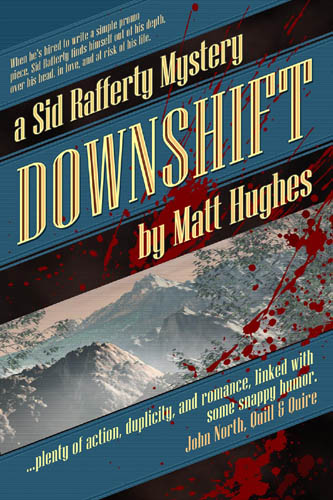

So there’s that dream. It’s one of those dreams that’s so commonplace that it seems like everyone has had it, and maybe more than once: you find yourself back at school, standing in front of an entire room – or even an auditorium – full of students, and you’re about to speak when you look down and realize that you’re not wearing any pants.
This is not about that dream.
That dream is commonplace; it’s not worth our time.
Let’s imagine, instead, that the school we’ve returned to is the hellishly competitive, hellishly dangerous, and, in general, just plain hellish Retropolis Academy for the Unusually Inventive. This is the prestigious alma mater of every mad scientist in Retropolis. On graduation, students are propelled into the Experimental Research District where some of them will prosper and the other ones won’t be talked about very much. Not after the mess gets mopped up, anyway. Unless it’s a really amazing mess.
Awful as this is, it isn’t awful enough to compete with the no-pants version of the story, of course. And the good news is that there are pants in this version.
But that’s the extent of the good news. The rest of the news is that there are gigantic venomous worms, an unseasonal invasion of mole people, some devices that in all honesty should be better regulated, and very little respect for the guest lecturer. This is full contact, extreme higher education we’re talking about here.
And it starts this Wednesday, in Fenwick’s Improved Venomous Worms, at Thrilling Tales of the Downight Unusual.
This entry was posted on Tuesday, September 6th, 2016
and was filed under Thrilling Tales of the Downright Unusual, Works in Progress
There have been no responses »

If you were following along a couple of months ago, you probably know that at that time I was working on the dust jacket art for my book Slaves of the Switchboard of Doom.
I couldn’t show it to you back then. That’s because the auspicious moment for a cover reveal is determined during ancient, eldritch rituals around the smoking braziers and in between the ragged and unsettling tapestries of the towers that brood over the isle of Manhattan.
Yeah, that’s really how they do it. They’re old school, over there.
But last week my editor showed off the front cover and wraparound versions of the dust jacket. So here it is – front cover above, and the whole dust jacket below.
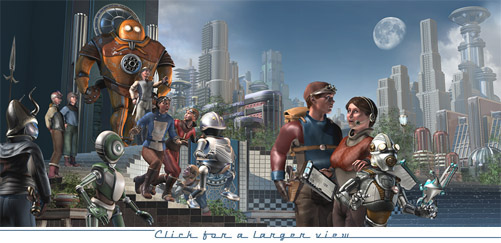
The Old Cover
If you’ve been following along even longer you may remember that I did a cover design for the book, back before it even was a book. It looked like this:

I really liked the vintage paperback palette and the detail of Rusty hanging on to the rocket in a kind of homage to Josh Kirby’s Discworld covers. But I also figured that if a publisher wanted the book, some other artist would end up doing the cover… because cover art is another matter that’s decided during those archaic festivities that I mentioned above.
So I was happy to learn that even though Tor didn’t want my original cover, they did want me to do a new one.
The New Cover
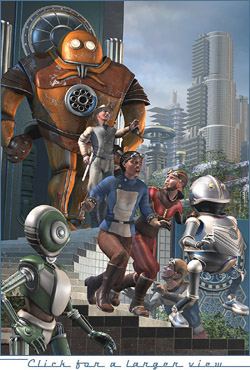
In March I got a rough description of the cover they wanted, and that’s more or less what you see on the front.
But because it was to be a wraparound jacket I had all sorts of room to show the rest of what they wanted, which was the city of Retropolis; and I took advantage of the situation by doing on the back cover what I really wanted to do: a whirlwind of characters in another light homage to Josh Kirby.
Because nothing says ‘humor’ better than a crowd of frightened people who are running for their lives.
But, hey, I’m getting ahead of myself.
The Roughs
First I worked up a series of roughs: there were six of them. Like most of what I do, these roughs started in 3DS Max and were finished (rather lightly, for the roughs) in Photoshop. They were very, very preliminary.
For complicated reasons it seemed like it would be better to offer fewer choices than that, so I cut it down to two. Of those two they picked the rough that I liked best. You can see that one below.
And although I didn’t realize it at the time, that rough is the cover you see now at Amazon, and at Barnes & Noble, and everyplace else where the book’s mentioned. Now that the cover’s been revealed we should eventually see the real cover show up in all those places. I’m eager to see that happen.
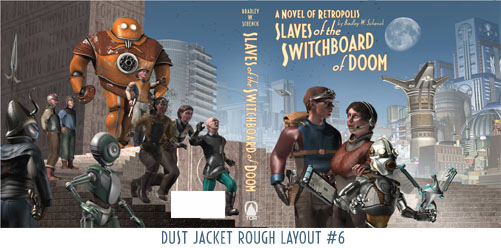
The Layers
At the rough stage I still had no idea what my polygon count would be in 3DS Max. (Over seven million!) But it was obvious that I’d need to handle the scene in multiple layers. In the end, there were at least six of these layers. (It’s hard to be exact, because there were problems that showed up only when I’d rendered the scene at a high resolution – so I went back, near the end, to render out my fixes for those.) At the very end I put all the layers together in Photoshop, where I did all kinds of retouching on them until they were a picture.
The biggest single task was the city in the background. For the rough I’d just pasted in bits and pieces of my existing city backdrops to get the building masses about where I wanted them. For the final I had to model new buildings and arrange them all into a layout that made sense. So of the six weeks I spent on the picture, I spent two in the city.
Lighting is always a large task, and here I was lighting about six separate scenes that needed to match. I know this sounds simple: but this isn’t photography. I’m not documenting. The lighting all had to look correct, but in fact it’s subverted and bent in countless ways that better serve the picture.
The simulation above doesn't really show you what I was working on; I often went forward and backward through the layers, and as I worked, of course, I hadn't done any retouching. But you can see what pieces I was working on, even though they look much prettier here.
The Big Picture
Finally, while the dust jacket is large - it's about twenty-one inches across - I wanted it to be even larger. So at its full resolution the picture will become a poster and an archival print at about thirty inches by fifteen.
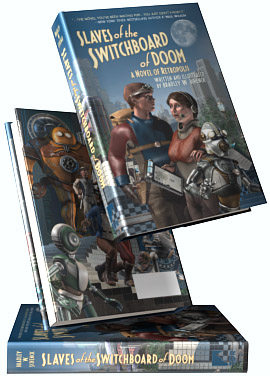 I really enjoyed working on this, which is a strange thing to say about six weeks of incessant minor changes and test renderings; but there it is.
I really enjoyed working on this, which is a strange thing to say about six weeks of incessant minor changes and test renderings; but there it is.
The dust jacket is a set of panels that have to work together as a single picture, but which also need to stand on their own when they’re seen on the book: the front and back flaps, the front and back covers, and even the spine will be seen as separate pictures once the dust jacket is folded around the book. It’s a really interesting challenge.
And that set of pictures has to show the shopper what the heck this book is about.
By that I don’t mean what happens in the book. It’s more a question of what the book is like.
So, the way I see it, this is what my book is like:

Oh! And you remember that old cover design? It turned into a pretty great title page. Because we waste no part of the animal.
This entry was posted on Tuesday, August 23rd, 2016
and was filed under Slaves of the Switchboard of Doom, Thrilling Tales of the Downright Unusual, Works in Progress
There have been 5 Responses »

If today’s mysterious snippets center on themes of escape and retaliation, that’s all due to August’s attempts to melt the Secret Laboratory around my ears. But I’m on top of it! It’s so seldom I get a chance to test my latest experiments on an entire month.
But apart from that these are more glimpses of things to come for The Retropolis Registry of Patents – in one case, not until the end of the year.
The fifth story in the series won’t begin until late November, and it’s a long one that will continue on into February. Which is nice, from a calendrical point of view, but if you do the math you’ll realize that I have to do more illustrations for that one (Ten! Count ’em! Ten!). And I’ve just finished the fifth, so the rest of the calculation is left as an exercise for the reader.
Meanwhile, this week things are about to take a turn for the more peculiar in Doctor Petaja’s Parlor of Peril.
In some ways I thought that Doctor Petaja was a perfectly good introduction to the series – maybe even better than The Purloined Patents of Doctor Brackett – but I like the way we meet Ben and Violet in Brackett, so I decided to let it stand rather than have us meet them after they’ve gotten to know each other. Maybe I’ve given in a little to Hollywood’s addiction to origin stories.
Example? Robert E. Howard never wrote an origin story for Conan. Conan doesn’t need an origin story. You know exactly who he is once you see him hit the world sandals-first and sword foremost. But each time Hollywood’s tried to adapt the poor Cimmerian they’ve felt that they had to explain to us how he got that way. Which, like I said, is completely unnecessary. How does a panther get that way? By being a panther.
Panthers aren’t impressed by origin stories. Panthers watch you become entranced by an origin story, and then they leap down out of a tree and eat you.
Aaaaand that’s totally out of left field, for which I also blame the August heat, and with that I had better let you go.
But keep an eye on Doctor Petaja this week. It may help with issues of job training and questions of whether you should really read the employee handbook.
This entry was posted on Sunday, August 14th, 2016
and was filed under Thrilling Tales of the Downright Unusual, Works in Progress
There have been no responses »

With its well-stocked cockpit, its stylish beetle-wing doors, and its incomprehensibly alien controls, this is the spaceship of Gzhurka – known, at least to himself, as The Great Gzhurka – and with this I kind of hope I’ve finished my weeks-long alien kick so I can get back to work on something else.
It’s really hard to deal with life when things keep spilling out of the Idea Closet.
I’m not really complaining. I mean, there are all those other days when the Idea Closet’s door gets stuck and I’m left standing just outside, listening to the soft rustling of things in there that I can’t quite identify. Which is sort of spooky.
But now at least I’ve figured out who this little guy is; I even know about something that happens to him. And I expect I’ll get to that later, when that makes more sense.
Later would be smarter.
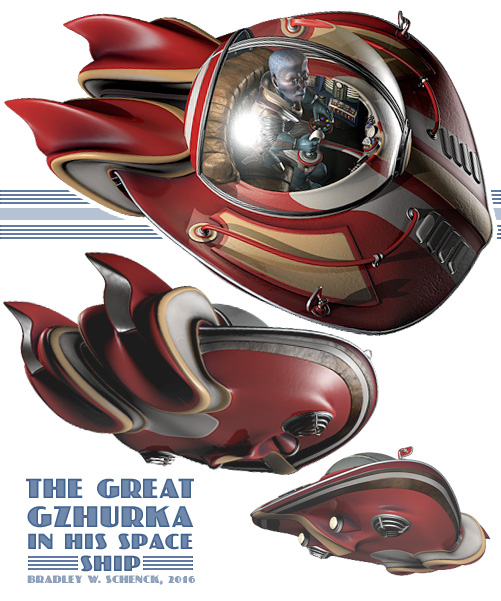
But I do think that the Great Gzhurka has a story or more to tell, and there’s a pretty good chance that I’ll deal with that… like I said, later, for the reason that, like I said, later would be smarter.
I still need to finish the illustrations for the fifth story from the Files of the Retropolis Registry of Patents; and then there’s the final story in that sequence to worry about too – though we won’t see that one for quite awhile. So it’s possible that Gzhurka will cut ahead in the line. He has very little regard for the feelings of other people.
This space ship is a bit different from my Retropolitan rockets because Gzhurka uses it for such long trips. Its cockpit has to be full of all the stuff that you need when you’re an alien who pretty much lives in his car. It’s the most complicated interior I’ve ever built for one of these and (of course!) along with its gizmos and cabinets and blinky buttons it even contains some reading material. Because that’s important.
And also later, right? Because later would be….
This entry was posted on Sunday, July 31st, 2016
and was filed under Works in Progress
There have been no responses »
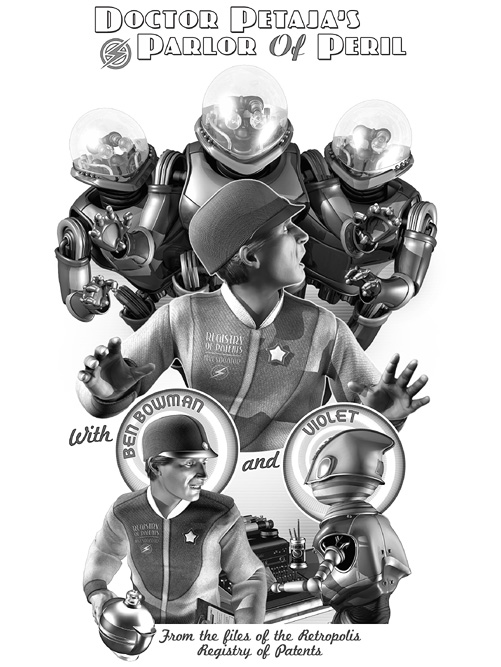
So in The Purloined Patents of Doctor Brackett we’ve encountered the Retropolis Registry of Patents; and while we were there we met Ben Bowman, Investigator, and Violet, the robot secretary who really ought to be an Investigator… and who intends to make that happen by any means necessary.
Office politics can always be a bit on the risky side. That’s never been more true than in the Registry of Patents.
Violet is resourceful and dedicated and – although she’s quite a nice mechanical person who makes an excellent cup of coffee – nobody’s ever mentioned to her that thing we call the Three Laws of Robotics.
But in addition to Violet’s next move on the new Registrar we’re going to see what can happen when one mad scientist floods the Registry with stack after stack of preliminary patent applications; we’ll wonder what that might mean, especially for the whales; and we may even find out what’s so important about the Registry’s regulation #527b. (Hint: it’s not the one about the "Procedure For Requesting Laboratory Egress".)
All this and more will be revealed in the weekly installments of Doctor Petaja’s Parlor of Peril at Thrilling Tales of the Downight Unusual. It starts on Wednesday.
This entry was posted on Monday, July 25th, 2016
and was filed under Thrilling Tales of the Downright Unusual, Works in Progress
There have been 2 Responses »
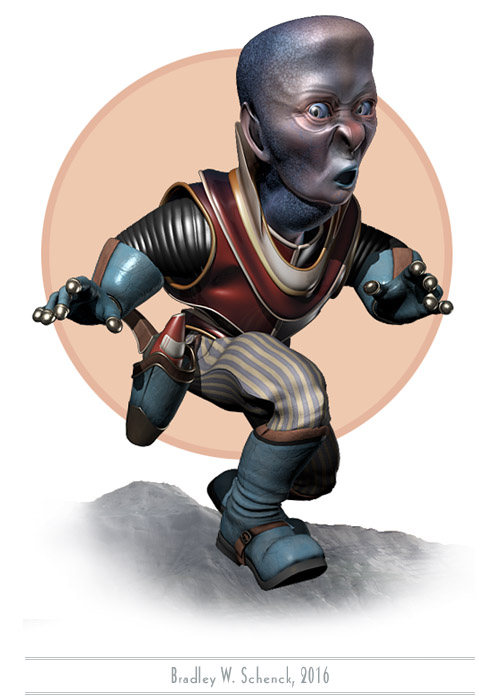
I still don’t have any idea who this is. I can’t help but speculate, though.
I mean, I’ve been wondering a lot about what sort of character he(?) might be even as I cursed myself for working on him/her/it for most of the week when I should have been doing something else. Still – whatever it is – it’s about done, so I should be able to tone down the cursing for awhile.
Fun fact: I added a morph target that I call “Frog Throat”, in which the critter’s throat blows up big like a bullfrog’s. Why? It’s the same old question. I think the answer must be “because”.
I’m sure he/she/it will turn out to be important (maybe even essential!) someday. In the meantime I’ll just keep wondering.
This entry was posted on Saturday, July 16th, 2016
and was filed under Computer Graphics, Works in Progress
There have been 2 Responses »
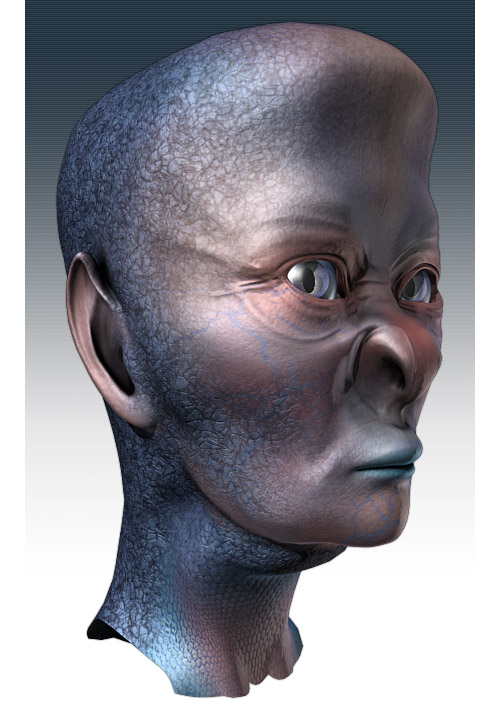
It’s with no small amount of pride that I can now reveal my second, and most successful, human hybrid experiment. I wish I knew exactly what it was; but, as you can see, it’s keeping an eye on us until I figure that out.
Over the past year or so I’ve learned some new tricks with my morph-targeted character heads, and the most interesting tricks are the ones I can play on characters that are already done. Some of this is due to Collapse to Morpher, a very useful 3DS Max script.
Morphs are terrific, but they rely on the source object and its morph targets sharing the exact same topology. That means they need to have the same number of vertices, and (importantly!) those vertices have to be numbered in the same order. If you’re not careful you can end up with two objects that used to share those properties but which now are subtly and fatally different. You just can’t morph them any more.
You can change an object after applying the morpher, and that works because the morphing action takes place before all those changes. But when you do that you end up with a new stack of modifiers on top of the morpher that can’t be collapsed. Every time you make a change to a scene with the modified object present, and in particular every time you change its morph states, all of the post-morph modifiers have to be recalculated in the scene. That slows things down. Slowing things down makes me cranky.
Collapse to Morpher does this crazy, complicated thing in which the entire stack of modifiers is applied to an extracted version of each morph target. Then the morph targets are added to a collapsed version of the original object and then suddenly, or possibly not entirely suddenly, you have a new streamlined version of the object with its new, equally streamlined morph targets, and things are quick again and I’m less cranky.
That’s how I’ve worked out ways to blend between two finished character heads, to optimize existing characters, to save time on operations like calculating vertex colors and UV mapping, and – now – to turn a human being into something entirely different.
I did something like this once before. But at that time I didn’t have a practical way to salvage the original morph targets for the character’s facial expressions.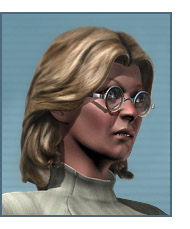
So here’s a little picture of my unwitting experimental subject, Dr. Lillian Krajnik. I started by cloning her (as one does) and then edited her head into the head you see at the top of this post. Once the clone was completely mutated I used Collapse to Morpher to turn it into a new, streamlined character – with all its original expression morphs updated as well. My weird fishy, lizardy human hybrid frowns and smiles and sneers and look surprised, on command, just like Lillian does. Almost automatically.
This stuff is just so cool when it actually works.
I have a little work to do on a few of the morph targets. The nostrils are so different now that any time they rise or expand they behave a little differently, and the eyes don’t close completely as they used to do. But editing that handful of morph targets is so much simpler than starting from scratch, every time.
So now I’m a human hybrid maker. In whatever odd moments I have over the next few months I think it’s going to get all Doctor Moreau in here.
This entry was posted on Tuesday, July 12th, 2016
and was filed under Computer Graphics, Works in Progress
There have been no responses »
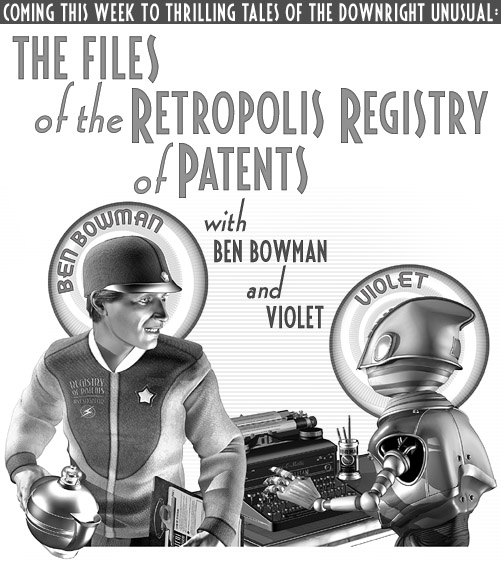
After a long hiatus, the serial stories at Thrilling Tales of the Downright Unusual begin again this Wednesday.
Welcome to the Retropolis Registry of Patents: a bureau of hard-working Officers and Investigators who file patent registrations for countless mad scientists – at no small risk to themselves – and who discreetly keep track of which deranged inventor is about to create an innovation so hazardous that it needs to be stopped.
Their work may be as insane as their clients are. But like any other person, whether human or mechanical, what’s really important to them is office politics.
This is a series of short stories – illustrated in glorious black and white! – which will run from six to ten weeks each.
We begin on Wednesday with The Purloined Patents of Doctor Brackett, in which we meet several people we’ll come to know in the series while we get our first look at the inner workings of this important, undervalued department of Retropolis’ City Government.
The serials will update just once a week; but because each update is around 1000 words you’ll get bigger weekly chunks of story than you saw in The Lair of the Clockwork Book, which updated twice each week.
Here’s the complete schedule for the year:
-
The Purloined Patents of Doctor Brackett (June 15)
-
Doctor Petaja’s Parlor of Peril (July 27)
-
Fenwick’s Improved Venomous Worms (Sept. 7)
-
Professor Wilcox and the Floating Laboratory (October 19)
-
Ben Bowman in the Vault of Terror (November 30)
And after that? This schedule carries us into February 2017, so forgive me if I haven’t figured that part out yet.
I will be a little bit mean to you: the Registry of Patents stories are meant to conclude with a final story that will appear only in print, probably late next year. Still, after Vault of Terror there may be another story lined up. It just won’t be a Registry of Patents story.
I’ll probably have figured that out before the end of the year. In the meantime, enjoy what’s coming this Wednesday… and every other Wednesday for the rest of the year.
This entry was posted on Monday, June 13th, 2016
and was filed under Thrilling Tales of the Downright Unusual, Works in Progress
There have been no responses »

Yeah, I’m just building the World of Tomorrow, the way you do.
I know it’s been quiet on the blog front; as always that means I’m working really hard on something you can’t see yet. It’s nice. But why believe me?
We’re getting ever closer to June 15th, that happy day when The Purloined Patents of Doctor Brackett will begin its serial run over at Thrilling Tales of the Downright Unusual, and that’s just the beginning of a series of illustrated short stories that will continue through early next year. Most of those are in the can already, so you can tell they’re not what I’m working on right now.
What I am working on right now is related to the World of Tomorrow as you see it up above. That’s as much as you get, for the moment.
One thing I’ve been enjoying recently when I’m not building Retropolis is a long-running series of medical science fiction stories by James White. I don’t know how I missed them before, but that’s just made it more fun to find them now.
The stories takes place in and around Sector Twelve General, a massive multi-species hospital that hangs in space. The staff and their patients come from a bewildering number of species – so much so that they’ve adopted a four-letter mnemonic system for identifying themselves – and each story centers on a medical mystery. There are uncooperative patients as big as continents, and frightened patients who’ve never seen the members of another intelligent species before, and sightless beings who communicate telepathically, and a gazillion more.
The first stories date from the late 1950’s, but they continued to appear for decades. One interesting thing about reading them now is that you can watch the cultural shifts in our own world while the author evolves and grows. It’s great stuff; you should try it.
This entry was posted on Friday, May 27th, 2016
and was filed under Thrilling Tales of the Downright Unusual, Works in Progress
There have been no responses »
Over at his Archonate blog, Matthew Hughes has posted an announcement for the eBook and audiobook editions of his late-90’s mystery novel Downshift. There’s a comedy of errors about its first publication and the circumstances under which he wrote its sequel, Old Growth, which will also soon be republished under his own brand.
Then, three months before Downshift came out, my editor departed for another publisher– a nonfiction house, so she couldn’t take me with her. Immediately my print run was cut, my tiny promotional budget went to another book, and the marketing effort, except for library sales, was a few mouse-sized squeaks. Months later, when I asked if there were remaindered copies I could buy, I was told, “Nope, as the returns came in we sent them straight to the pulper.”
Not so comedic, maybe. But then again, I think I remember one definition of comedy as a story that relates events to their human sufferer, while tragedy connects events to their hidden cause.
A paperback edition is forthcoming, which I know because (as usual) I laid out the book in mobi, ePub, PDF and print formats. This time I also did the cover, a nice match to the Old Growth cover that will also be coming along soon.
This entry was posted on Sunday, May 15th, 2016
and was filed under Found on the Web, Works in Progress
There have been no responses »













 I really enjoyed working on this, which is a strange thing to say about six weeks of incessant minor changes and test renderings; but there it is.
I really enjoyed working on this, which is a strange thing to say about six weeks of incessant minor changes and test renderings; but there it is.
















